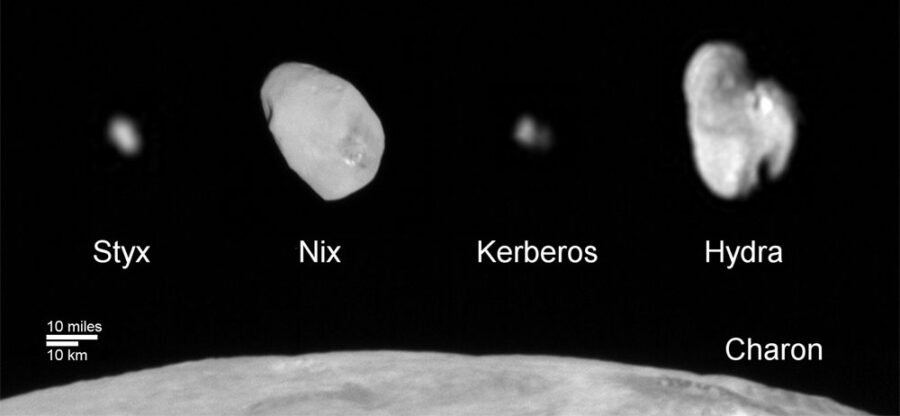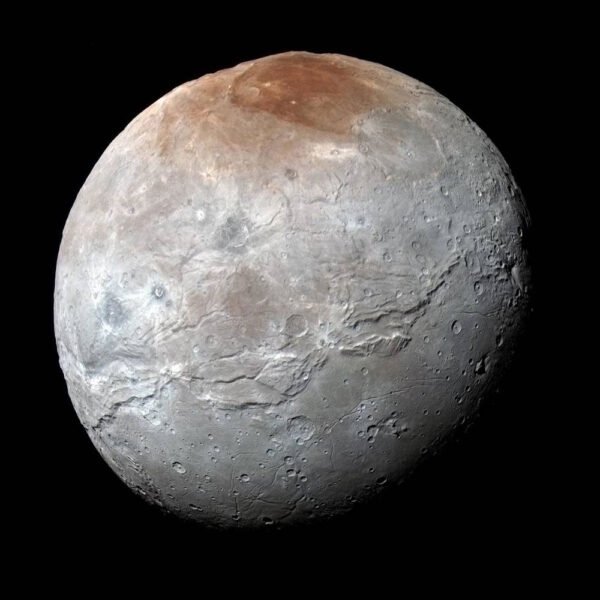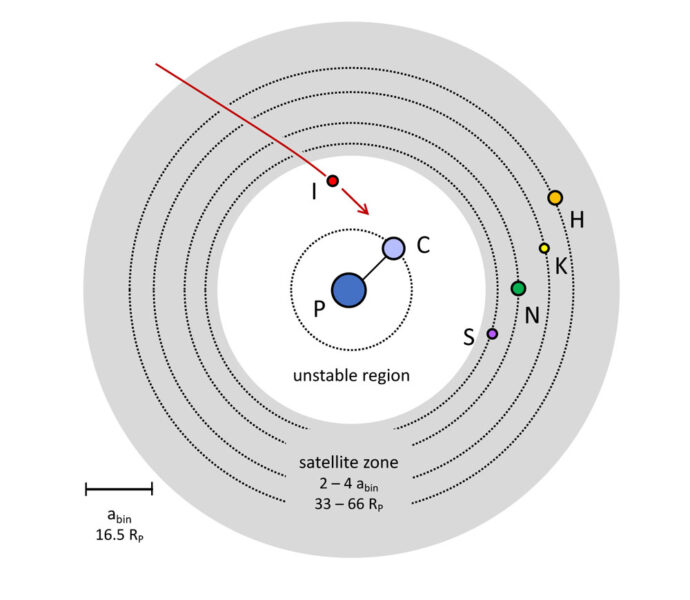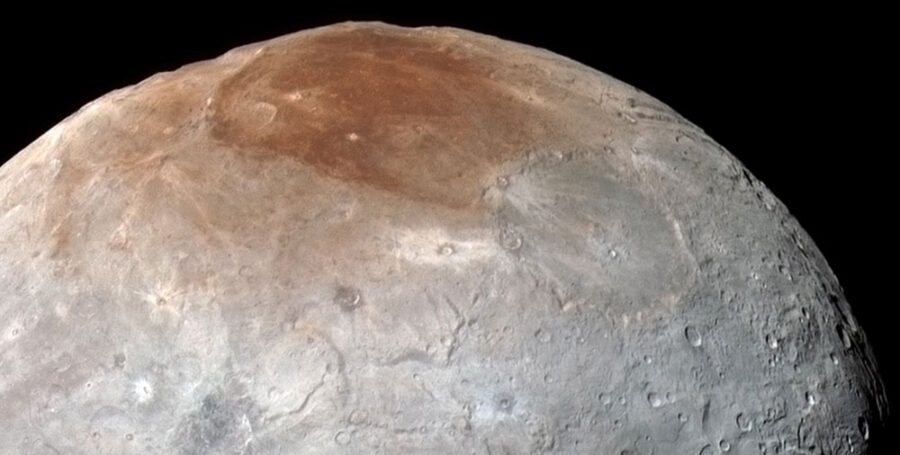A massive collision with Pluto’s moon Charon could have formed the dwarf planet’s collection of smaller moons.

NASA / JHUAPL / SwRI
Pluto's four tiny moons may not have been born at the same time as their larger sibling, Charon. While previous studies predicted that all five natural satellites sprang from Pluto after a giant impact smashed into the dwarf planet, new research suggests that a second, subsequent collision might have formed the smallest satellites.
The research, conducted by Benjamin Bromley (University of Utah) and Scott Kenyon (Center for Astrophysics, Harvard & Smithsonian), appears in the August Astronomical Journal (full preprint here).
Making Moons
Charon was first spotted in 1978. The moon is so large compared to its planet that the center of gravity of the pair is outside Pluto, leading many to refer to the two as a binary system. The system’s four smaller moons — Styx, Nix, Kerebos, and Hydra — weren't discovered until 2006, after NASA's New Horizons mission had already begun its decade-long journey to the outer solar system.

NASA / JHUAPL / SwRI
As early as the 1980s, researchers had suggested that Charon came together after an object smashed into Pluto. Other simulations suggested that the four smaller moons could be debris from the same impact. But there were a few problems with the latter scenario.
"If the small moons formed with Pluto and Charon, then they would have trouble surviving the changing gravitational pulls as Pluto and Charon settled out from their dramatic origin," Bromley explains. The pair's strong tidal interactions slowly pushed them apart after their formation and circularized their orbits. "The impact of this outward dance — and its gravitational push and pulls — would have cleared out the region where some of the moons are today," Bromley adds.
New Horizons team member Mark Showalter, who led the observing campaign that discovered two of the moons but wasn’t involved in the current study, put it in simple terms: "It is hard to get the material there and it is hard to keep it there."
Spurred in part by the new observations, Bromley decided to explore whether the four satellites could have been birthed in a second smashup. Working with Kenyon, Bromley found that an impactor of at least 1018 kilograms, roughly 1,000 times less massive than Pluto or Charon, could have carved the four moons from the surface of one of the binary worlds.
"This seems like an elegant solution to the problems with the earlier models," Showalter says.

B. Bromley & S. Kenyon / Astronomical Journal 2020
"An Elegant Solution"
For many years, the two closely orbiting worlds appeared as a single object, until astronomer James Christy realized that Pluto appeared elongated in some images — and that the elongation changed direction over Pluto’s rotation period.
Pluto and Charon are roughly the same size in both radius and mass, but when New Horizons flew by in 2015, it revealed that the two worlds are quite different. While Pluto is coated with methane ice, Charon is mostly rock, with only a smudge of red ice on its surface. Parts of Pluto had few craters, suggesting that its surface continues to evolve long after scientists thought it would have gone to sleep. Charon, on the other hand, boasts a crater-filled landscape likely as old as the solar system itself.
New Horizons also caught a brief glimpse of the four tiny moons, revealing their rapid spins and unusual, tipped orientations.
Intrigued, Bromley and Kenyon decided to re-investigate the classical model that called for all five moons to form from the same impact. The birth of the small moons require an impact that would eject at least 1018 kilograms of material from Charon (similar to the mass of the impactor itself), although uncertainties about the composition of the impactor and of Charon affect the estimate's precision. The researchers set about trying to determine how large such an object would be.
Rewinding the solar system back 4.5 billion years to its beginning is a complex process; a single change can result in completely new scenarios. So researchers rely on probability to figure out what most likely happened.
"It's all about the odds of an impact, which are not great to begin with," Bromley says. That’s because smaller objects outnumber their larger siblings in the Kuiper Belt. The researchers also had to calculate which body was impacted, Charon or Pluto. Pluto's larger size means it’s a more likely target than its moon, but its larger size requires a larger KBO to carve out the right amount of material.
The researchers found that a direct hit by a 50-kilometer (30-mile) object was the most likely scenario, though a well-aimed 30-kilometer bullet could have ejected enough material to build the moons if it hit Charon just right.
Searching for Signs of an Ancient Impact
But if a massive KBO did collide long ago with rocky Charon, would it have left a mark? The researchers think so. Bromley says he and Kenyon had found a potential candidate, the 240-km-diameter Dorothy Crater. Although the object that formed Dorothy would likely have been too small, only 20 km across, lack of knowledge about Charon’s interior means that it might have been larger and can’t be completely counted out.

NASA / JHUAPL / SwRI
However, Showalter is a bit skeptical that Charon's surface shows signs of such an impact. "The model predicts that there was one, and only one, impact into Charon that was large enough to form the small moons," he says. He would then expect there to be a single, exceptionally large crater on Charon, but none stands out. "It's a bit hard to say that the surface of Charon really provides any direct evidence in support of this model," Showalter says. "Still, we can't rule it out."
Another concern Showalter raises is that two large objects would have had to collide with the Pluto system, one to form Charon and the second to create the other moons — an unlikely scenario. "As the saying goes, lightning doesn't strike twice in the same place," he says. Nevertheless, he adds, "in reality, sometimes it does."
Bromley and Kenyon plan to continue their investigations, and Showalter too says, “There is still more work to be done."
 1
1









Comments
Bluestar5
August 30, 2020 at 7:20 am
Great article! Despite Pluto's demotion several years ago, we still have a lot to learn about it and its plantetoid cousins.
If the center of gravity for Pluto and Charon cause it to be a binary set of "planetoid and moon", has it been observed by astronomers that Pluto appears to wobble as they both swing or rotate in their orbital path?
You must be logged in to post a comment.
You must be logged in to post a comment.